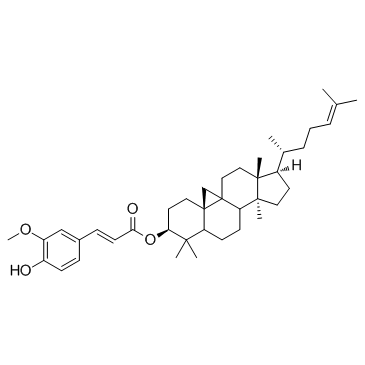11042-64-1
| Name | Gamma-Oryzanol |
|---|---|
| Synonyms |
Cycloartenylferulate
(3b,9b)-9,19-cyclolanost-24-en-3-yl (2E)-3-(4-hydroxy-3-methoxyphenyl)prop-2-enoate (3β,9β)-9,19-cyclolanost-24-en-3-yl (2E)-3-(4-hydroxy-3-methoxyphenyl)prop-2-enoate gamma-Oryzanol (3β,9β)-9,19-Cyclolanost-24-en-3-yl (2E)-3-(4-hydroxy-3-methoxyphenyl)acrylate MFCD00867548 Oryzanol A 2-Propenoic acid, 3-(4-hydroxy-3-methoxyphenyl)-, (3β,9β)-9,19-cyclolanost-24-en-3-yl ester, (2E)- γ-Oryzanol EINECS 244-285-1 |
| Description | γ-Oryzanol is a potent DNA methyltransferases (DNMTs) inhibitor in the striatum of mice. γ-Oryzanol significantly inhibits the activities of DNMT1 (IC50=3.2 μM), DNMT3a (IC50=22.3 μM). |
|---|---|
| Related Catalog | |
| Target |
DNMT1:3.2 μM (IC50) DNMT3A:22.3 μM (IC50) |
| In Vitro | γ-Oryzanol significantly inhibits the activities of DNMT1 (IC50=3.2 μM), DNMT 3a (IC50=22.3 μM) and DNMT 3b (maximum inhibition 57%). In contrast, the inhibitory activity of Ferulic acid, a metabolite of γ-Oryzanol, is much lower than that of γ-Oryzanol. Furthermore, γ-Oryzanol acts as a partial antagonist against ERRγ, which primarily serves as a positive regulator for DNMT1 production, and consequently decreased the activity of DNMT1[1]. |
| In Vivo | The brown rice-specific bioactive component γ-Oryzanol, a mixture of ferulic acid ester and several phytosterols, attenuates the preference for dietary fat via a decrease in hypothalamic endoplasmic reticulum (ER) stress. γ-Oryzanol ameliorates HFD-induced DNA hypermethylation of the promoter region of D2R in the striatum of mice. γ-Oryzanol might regulate levels of DNMTs in a striatum-specific manner. γ-Oryzanol partially decreases ERRγ activity (an approximately 40% reduction of the innate value). Oral administration of γ-Oryzanol to male mice by gavage significantly attenuates the preference for an HFD (93% of the values for vehicle-treated mice), resulting in an apparent attenuation of body weight gain[1]. |
| Kinase Assay | To assess the inhibitory activity of each compound on DNA methylation, the formation of S-adenosyl-l-homocysteine (SAH) is measured in the presence of each compound (20 μM for screening assays),S-adenosyl methionine (SAM; 10 μM) and DNMT substrate (4 ng/μL) at 37°C for 90 min. To evaluate the Michaelis-Menten kinetics, DNMT1 (20 μM) is incubated with γ-Oryzanol, SAM (5 μM) and the indicated concentration of poly dI-dC at 37°C for 90 min. DNMT3a (100 μM) and DNMT3b (100 μM) are incubated with γ-Oryzanol, SAM (5 μM) and the indicated concentration of poly dG•dC at 37°C for 120 min. The assays are performed in quadruplicate. Extracted protein (0.75 mg/mL) is incubated with SAM (5 μM), poly dI-dC (5 μg/mL), and poly dG•dC (5 μg/mL) at 40°C for 120 min, and SAH formation is measured[1]. |
| Animal Admin | Mice[1] Seven-week-old male C57BL/6J mice are used. To evaluate the preference for the HFD, γ-Oryzanol is administrated to 8-week-old mice by gavage during the food choice test. For the other experiments, an HFD containing 0.4% γ-Oryzanol is manufactured as pellets. After 12 weeks of feeding, tissue is collected from the striatum and hypothalamus. The daily intake of γ-Oryzanol, estimated from the mean food intake of the mice, is approximately 320 μg/g body weight. The doses of γ-Oryzanol are determined. |
| References |
| Density | 1.1±0.1 g/cm3 |
|---|---|
| Boiling Point | 663.2±40.0 °C at 760 mmHg |
| Melting Point | 135-137°C |
| Molecular Formula | C40H58O4 |
| Molecular Weight | 602.886 |
| Flash Point | 193.8±20.8 °C |
| Exact Mass | 602.433533 |
| PSA | 55.76000 |
| LogP | 12.85 |
| Vapour Pressure | 0.0±2.1 mmHg at 25°C |
| Index of Refraction | 1.570 |
CHEMICAL IDENTIFICATION
HEALTH HAZARD DATAACUTE TOXICITY DATA
|
| Hazard Codes | Xi |
|---|---|
| RIDADR | UN 2811 6.1/PG 2 |
| RTECS | RN0050000 |
| HS Code | 2932999099 |
| HS Code | 2932999099 |
|---|---|
| Summary | 2932999099. other heterocyclic compounds with oxygen hetero-atom(s) only. VAT:17.0%. Tax rebate rate:13.0%. . MFN tariff:6.5%. General tariff:20.0% |

